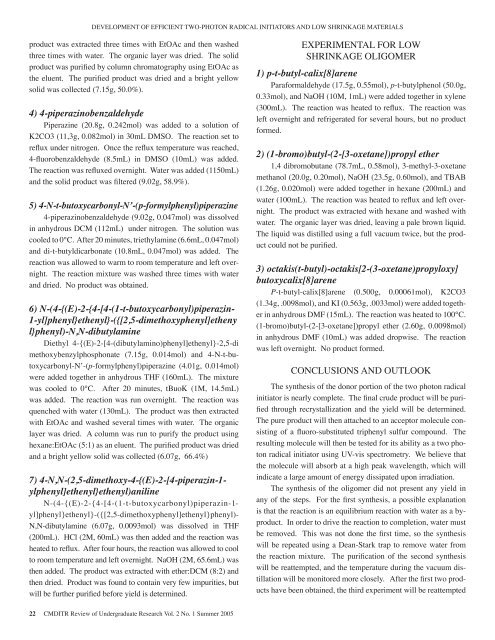Student Project Abstracts 2005 - Pluto - University of Washington
Student Project Abstracts 2005 - Pluto - University of Washington
Student Project Abstracts 2005 - Pluto - University of Washington
You also want an ePaper? Increase the reach of your titles
YUMPU automatically turns print PDFs into web optimized ePapers that Google loves.
DEVELOPMENT OF EFFICIENT TWO-PHOTON RADICAL INITIATORS AND LOW SHRINKAGE MATERIALSproduct was extracted three times with EtOAc and then washedthree times with water. The organic layer was dried. The solidproduct was purified by column chromatography using EtOAc asthe eluent. The purified product was dried and a bright yellowsolid was collected (7.15g, 50.0%).4) 4-piperazinobenzaldehydePiperazine (20.8g, 0.242mol) was added to a solution <strong>of</strong>K2CO3 (11,3g, 0.082mol) in 30mL DMSO. The reaction set toreflux under nitrogen. Once the reflux temperature was reached,4-fluorobenzaldehyde (8.5mL) in DMSO (10mL) was added.The reaction was refluxed overnight. Water was added (1150mL)and the solid product was filtered (9.02g, 58.9%).5) 4-N-t-butoxycarbonyl-N’-(p-formylphenyl)piperazine4-piperazinobenzaldehyde (9.02g, 0.047mol) was dissolvedin anhydrous DCM (112mL) under nitrogen. The solution wascooled to 0°C. After 20 minutes, triethylamine (6.6mL, 0.047mol)and di-t-butyldicarbonate (10.8mL, 0.047mol) was added. Thereaction was allowed to warm to room temperature and left overnight.The reaction mixture was washed three times with waterand dried. No product was obtained.6) N-(4-{(E)-2-{4-[4-(1-t-butoxycarbonyl)piperazin-1-yl]phenyl}ethenyl}-({[2,5-dimethoxyphenyl]ethenyl}phenyl)-N,N-dibutylamineDiethyl 4-{(E)-2-[4-(dibutylamino)phenyl]ethenyl}-2,5-dimethoxybenzylphosphonate (7.15g, 0.014mol) and 4-N-t-butoxycarbonyl-N’-(p-formylphenyl)piperazine(4.01g, 0.014mol)were added together in anhydrous THF (160mL). The mixturewas cooled to 0°C. After 20 minutes, tBuoK (1M, 14.5mL)was added. The reaction was run overnight. The reaction wasquenched with water (130mL). The product was then extractedwith EtOAc and washed several times with water. The organiclayer was dried. A column was run to purify the product usinghexane:EtOAc (5:1) as an eluent. The purified product was driedand a bright yellow solid was collected (6.07g, 66.4%)7) 4-N,N-(2,5-dimethoxy-4-{(E)-2-[4-piperazin-1-ylphenyl]ethenyl}ethenyl)anilineN-(4-{(E)-2-{4-[4-(1-t-butoxycarbonyl)piperazin-1-yl]phenyl}ethenyl}-({[2,5-dimethoxyphenyl]ethenyl}phenyl)-N,N-dibutylamine (6.07g, 0.0093mol) was dissolved in THF(200mL). HCl (2M, 60mL) was then added and the reaction washeated to reflux. After four hours, the reaction was allowed to coolto room temperature and left overnight. NaOH (2M, 65.6mL) wasthen added. The product was extracted with ether:DCM (8:2) andthen dried. Product was found to contain very few impurities, butwill be further purified before yield is determined.EXPERIMENTAL FOR LOWSHRINKAGE OLIGOMER1) p-t-butyl-calix[8]areneParaformaldehyde (17.5g, 0.55mol), p-t-butylphenol (50.0g,0.33mol), and NaOH (10M, 1mL) were added together in xylene(300mL). The reaction was heated to reflux. The reaction wasleft overnight and refrigerated for several hours, but no productformed.2) (1-bromo)butyl-(2-[3-oxetane])propyl ether1,4 dibromobutane (78.7mL, 0.58mol), 3-methyl-3-oxetanemethanol (20.0g, 0.20mol), NaOH (23.5g, 0.60mol), and TBAB(1.26g, 0.020mol) were added together in hexane (200mL) andwater (100mL). The reaction was heated to reflux and left overnight.The product was extracted with hexane and washed withwater. The organic layer was dried, leaving a pale brown liquid.The liquid was distilled using a full vacuum twice, but the productcould not be purified.3) octakis(t-butyl)-octakis[2-(3-oxetane)propyloxy]butoxycalix[8]areneP-t-butyl-calix[8]arene (0.500g, 0.00061mol), K2CO3(1.34g, .0098mol), and KI (0.563g, .0033mol) were added togetherin anhydrous DMF (15mL). The reaction was heated to 100°C.(1-bromo)butyl-(2-[3-oxetane])propyl ether (2.60g, 0.0098mol)in anhydrous DMF (10mL) was added dropwise. The reactionwas left overnight. No product formed.CONCLUSIONS AND OUTLOOKThe synthesis <strong>of</strong> the donor portion <strong>of</strong> the two photon radicalinitiator is nearly complete. The final crude product will be purifiedthrough recrystallization and the yield will be determined.The pure product will then attached to an acceptor molecule consisting<strong>of</strong> a fluoro-substituted triphenyl sulfur compound. Theresulting molecule will then be tested for its ability as a two photonradical initiator using UV-vis spectrometry. We believe thatthe molecule will absorb at a high peak wavelength, which willindicate a large amount <strong>of</strong> energy dissipated upon irradiation.The synthesis <strong>of</strong> the oligomer did not present any yield inany <strong>of</strong> the steps. For the first synthesis, a possible explanationis that the reaction is an equilibrium reaction with water as a byproduct.In order to drive the reaction to completion, water mustbe removed. This was not done the first time, so the synthesiswill be repeated using a Dean-Stark trap to remove water fromthe reaction mixture. The purification <strong>of</strong> the second synthesiswill be reattempted, and the temperature during the vacuum distillationwill be monitored more closely. After the first two productshave been obtained, the third experiment will be reattempted22 CMDITR Review <strong>of</strong> Undergraduate Research Vol. 2 No. 1 Summer <strong>2005</strong>




